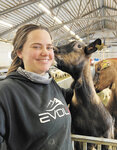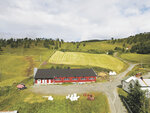


TROMSØ, Norway — On a farm next to a lake called Skogsfjordvatn, surrounded by mountains on an island called Ringvassøy, Mariell Solli Sørensen is the fifth generation of her family to farm in the northern Norwegian city of Tromsø.
Along with her parents, Sørensen milks a herd of 155 goats and raises 75 kids each year as the next generation of the family goat herd.
Sørensen’s family first purchased the farm in 1924 primarily as a means of feeding themselves. Each generation has improved and invested in the farm.
Faced with an aging barn in disrepair, the Sørensens built a well-insulated barn in 2009. The barn gave them a larger and more efficient working environment, with everything under one roof. At that time, the herd expanded from 100 goats to 250. The herd is milked in a double-24 parlor.
“We are usually pretty stable at about 240 goats, but something happened during our breeding season last year, and many goats, about 150, came up empty,” Sørensen said. “This made our immediate future as farmers uncertain, but with good help from an adviser, we managed to find ways to keep going with a smaller herd. Now, six months later, we are doing very well and getting used to the number of goats and workload.”
Caring for their herd is a priority for the Sørensens.
“Our goal has always been to breed healthy animals,” Sørensen said. “We focus on breeding goats with good milk quality and high production, but we also pay attention to the exterior and the temperament of the animals. A lot of thought goes into matching the goat with the right male.”
The Sørensens dehorn their entire herd to prevent damage to the facilities and reduce injuries.
“After we started dehorning all the animals, we see that our herd is much more calm and harmonic with each other,” Sørensen said. “There is less fighting, fewer repairs and happier goats.”
The topography of the Sørensens’ farm lends itself to grazing the herd in the temperate months but makes harvesting stored feed for the long winter challenging.
The farm consists of about 130 acres of cultivated land, 10 owned and 120 acres rented, on which they raise all forages for the herd.
“Late springs and wet, short summers put a lot of pressure on farmers to produce enough hay and silage to last throughout the winter,” Sørensen said. “Buying feed from other areas costs a lot due to distance. With high diesel prices, shipping feed is more expensive than the feed itself.”
The cold, wet summers affect Norwegian farmers well beyond the confines of summer.
“Owning such little cultivated land, it is both expensive and time-consuming to harvest all the grass we need,” Sørensen said. “We rent fields in four different villages on the island. Some are separated from us by mountains, so driving to these fields 25-30 kilometers away can take 50 minutes.”
With increasing costs, the Sørensens are thinking of discontinuing the rental of the fields furthest from their farm.
“We live in the middle of both the mountains and the flat area, which is perfect for our goats,” Sørensen said. “Our winters are harsh with a lot of snow, and temperatures down to 35 degrees below zero Celsius. Our summers are either warm or cold and wet; it is always one or the other and never in between. The weather can be very different from year to year, so we never know what we are going to get, but we have learned to prepare for the worst and appreciate the good years.”
Farmers in northern Norway have few choices when it comes to marketing their milk, Sørensen said.
“Unless you want to sell your milk yourself, you are limited to only one factory that will buy your milk,” Sørensen said.
The Sørensens market their milk through a company called TINE.
“There are very strict rules and regulations in Norway regarding the production and sale of food and drinks you produce yourself,” Sørensen said. “So, it is most common to sell our milk to a company that facilitates the production, marketing and distribution of products to different stores.”
According to Sørensen, most of the milk consumed in Norway is produced by dairy cows rather than goats.
“In my county, there are only three dairy farmers left, and we are all goat farmers,” Sørensen said. “In total, there are only 230 dairy goat farms left in Norway, and on average, about 10 quit each year. It’s a sad statistic. Goat milk is more or less never marketed any way other than by farmers themselves at farmers markets or on social media platforms.”
Governmental and societal pressures felt by farmers around the globe plague Norwegian farmers too, Sørensen said.
“Farmers in Norway are not taken seriously by our government and some consumers or appreciated for the work we put into the food we put on everyone’s tables,” Sørensen said. “There is a lot of tension in Europe. Farmers are sick and tired of the workload with little pay. That tension has reached Norway, and farmers are putting pressure back on our government to do something about these problems. Many farmers are on the edge of just letting go and shutting down their farms, because they can no longer afford to keep going.”
Inflation and rising input costs create the same issues for Norwegian farmers as their global counterparts.
“The inflation of essential things farmers need to provide for our animals and take care of our equipment and running our farms is not in balance with the prices paid to farmers,” Sørensen said.
Despite the challenges, Sørensen said the goal for the future is to simply continue farming.
“Focusing on the quality of our production and living good lives ourselves keeps us going,” Sørensen said. “We hope that we can keep investing in our farm with newer equipment and new solutions to lighting, and improving the workload more for our own physical health. We hope that the pay will eventually start to go up, but we don’t have high expectations.”
Comments
No comments on this item Please log in to comment by clicking here